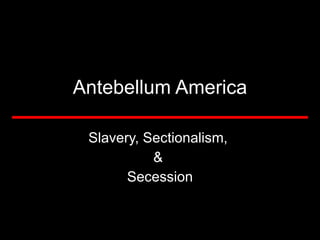Antebellum America
- 1. Antebellum America Slavery, Sectionalism, & Secession
- 2. Slavery Slavery in the West Northern Abolitionists Uncle Tomâs Cabin, 1852 Fugitive Slave Act
- 3. Slavery Documents Political Cartoon: âAm I Not A Man And Brother?â Sojourner Truth: âAânât I a Womanâ, 1851 Political Cartoon: âCouldnât I Walk Just as Well Without This Load Massa?â Political Cartoon: âThe Fruits of Amalgamationâ
- 4. Slavery Assignment Write a half page discussing the common message of the âMan and Brotherâ political cartoon and Sojourner Truthâs âAânât I a Womanâ speech.
- 5. Slavery Kansas-Nebraska Act, 1854 North: Transcontinental Railroad South: Slavery Left to Popular Sovereignty â Bleeding Kansasâ â Border Ruffiansâ & Lawrence John Brown Preston Brooks vs. Charles Sumner Dred Scott, 1857
- 6. Sectionalism Northerners argued for industrialization and the power of the Federal Government Southerners argued for agriculture (slavery included) and Stateâs Rights
- 7. Sectionalism Presidential Election of 1860 Candidates: Lincoln Wins Republican - Abraham Lincoln Democrat (North)- Stephen Douglas Democrat (South)- John Breckenridge Constitutional Union- John Bell
- 8. Sectionalism Assignment Complete the âSectional Conflictsâ worksheet.
- 9. Secession 7 States Secede Following the Election â too small for a republic and too large for an insane asylumâ Confederate States of America 4 More Secede Following the Attack on Fort Sumter December 1860 January 1861 February 1861 April 1861 May 1861 South Carolina Georgia Florida Alabama Mississippi Louisiana Texas Virginia Arkansas North Carolina Tennessee
- 10. Secession Assignment Read the âSecessionâYes or Noâ documents and complete the chart. Read the âPair of Presidentsâ document and write a paragraph contrasting the responses of James Buchanan and Abraham Lincoln to secession.
- 11. Resources Hollinshead, Byron. Documents that Shaped the American Nation in A History of US, vol. 11. New York: Oxford University Press, 2003. Sammis, Kathy. Focus on U.S. History: The Era of the Civil War and Reconstruction. Maine: J Weston Walch, 1997. Waldstreicher, David. A History in Documents: The Struggle Against Slavery. New York: Oxford University Press, 2001.
Editor's Notes
- #3: *Southerners wanted to expand slavery to the western territories. *Northern Abolitionists used propaganda to fight slavery. -Uncle Tomâs Cabin published in 1852 was one form of propaganda used. Its author, Harriett Beecher Stowe hoped it would bring a peaceful end to slavery. Instead, it inflamed Northerners against Southern plantation owners and angered Southerners who claimed that Stowe had given a biased and skewed representation of the slavery system. * Enforcement of the Fugitive Slave Act, which was used to force escaped slaves back to the South and Slavery was also highly controversial.
- #4: See handout
- #6: *When the Supreme Court ruled that the Missouri Compromise was an unconstitutional method for resolving the slavery question in new states, conflict broke out between pro-slavery Southerners and abolitionist Northerners. The conflict was resolved with the passing of the Kansas-Nebraska Act. -The Act promised funds to build a transcontinental railroad through the Northern portion of the country. This attempt to pacify the Northerners angry over the possibility of slavery in new territories played to Northern economic interests. -Southerners were satisfied with the Actâs declaration that members of new states would vote over the slavery question. This decision avoided attacking the Southâs economic interests in sustaining slavery and also supported their push for Stateâs Rights. *Kansas broke out into violence as the two sides attempted to gain a majority in the territory. -âBorder ruffiansâ came poured into Kansas from Missouri voting illegally in favor of slavery in the new state. They used violent methods to achieve their ends like attacking the âfreeâ town of Lawrence. -John Brown retaliated for the attack on Lawrence by leading a group in killing pro-slavery settlers. -When Senator Charles Sumner of Massachusetts gave an anti-slavery speech, âThe Crime Against Kansas,â on the floor of the US Senate, Congressman Preston Brooks of South Carolina responded by beating him unconscious with a cane. *The Supreme Court ruled that a slave who had lived with his master in a free-state was not entitled to freedom based on where his master took him
- #8: The split in the Democratic Party and the presence of a third-party candidate allowed Lincoln to win by taking advantage of the divide in the votes of his opponents.
- #9: See handouts.
- #10: *Southern states felt that the election of President Lincoln was an attack on their way of life so they seceded from the Union. - A Northern man said this about South Carolina when they seceded from the Union. - The states that seceded formed their own country: the Confederate States of America.
- #11: See handouts.










